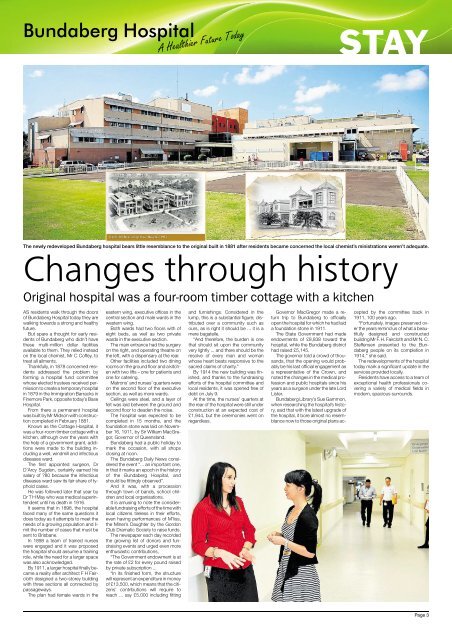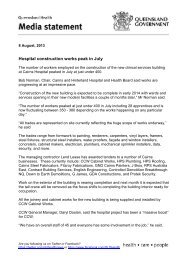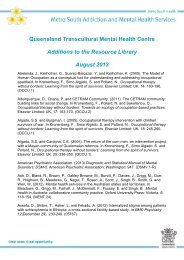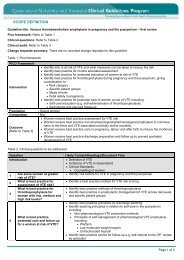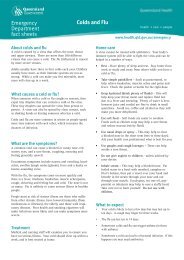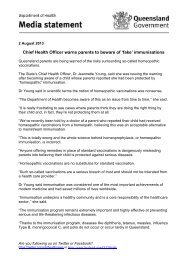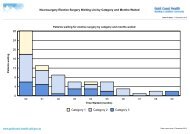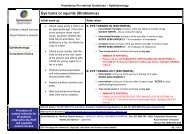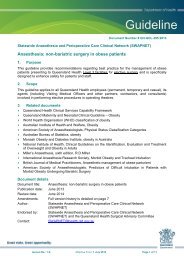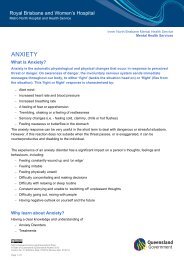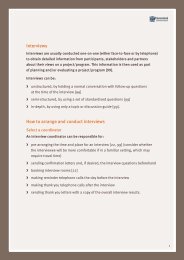A Healthier Future Today: Bundaberg Hospital - Queensland Health
A Healthier Future Today: Bundaberg Hospital - Queensland Health
A Healthier Future Today: Bundaberg Hospital - Queensland Health
Create successful ePaper yourself
Turn your PDF publications into a flip-book with our unique Google optimized e-Paper software.
<strong>Bundaberg</strong> <strong>Hospital</strong><br />
A<strong><strong>Health</strong>ier</strong> <strong>Future</strong> <strong>Today</strong><br />
STAY<br />
Changes through history<br />
The newly redeveloped <strong>Bundaberg</strong> hospital bears little resemblance to the original built in 1881 after residents became concerned the local chemist’sministrations weren’tadequate.<br />
Original hospital was afour-room timber cottage with akitchen<br />
AS residents walk through the doors<br />
of <strong>Bundaberg</strong> <strong>Hospital</strong> today they are<br />
walking towards astrong and healthy<br />
future.<br />
But spare athought for early residents<br />
of <strong>Bundaberg</strong> who didn’t have<br />
these multi-million dollar facilities<br />
available to them. They relied instead<br />
on the local chemist, Mr CCoffey, to<br />
treat all ailments.<br />
Thankfully,in1878 concerned residents<br />
addressed the problem by<br />
forming a hospital fund committee<br />
whose elected trustees received permission<br />
to create atemporary hospital<br />
in 1879 in the Immigration Barracks in<br />
FinemorePark, opposite today’sBase<br />
<strong>Hospital</strong>.<br />
From there apermanent hospital<br />
was built by Mr Midson with construction<br />
completed in February 1881.<br />
Known as the Cottage <strong>Hospital</strong>, it<br />
was afour-room timber cottage with a<br />
kitchen, although over the years with<br />
the help of agovernment grant, additions<br />
were made to the building including<br />
awell, windmill and infectious<br />
diseases ward.<br />
The first appointed surgeon, Dr<br />
D’Arcy Sugden, certainly earned his<br />
salary of ?80 because the infectious<br />
diseases wardsaw its fair shareoftyphoid<br />
cases.<br />
He was followed later that year by<br />
Dr THMay who was medical superintendent<br />
until his death in 1916.<br />
It seems that in 1898, the hospital<br />
faced many of the same questions it<br />
does today as it attempts to meet the<br />
needs of agrowing population and limit<br />
the number of cases that must be<br />
sent to Brisbane.<br />
In 1898 ateam of trained nurses<br />
were engaged and it was proposed<br />
the hospital should assume atraining<br />
role, while the need for alarger space<br />
was also acknowledged.<br />
By 1911, alarger hospital finally became<br />
areality after architect FHFaircloth<br />
designed atwo-storey building<br />
with three sections all connected by<br />
passageways.<br />
The plan had female wards in the<br />
eastern wing, executive offices in the<br />
central section and male wards in the<br />
western wing.<br />
Both wards had two floors with of<br />
eight beds, as well as two private<br />
wards in the executive section.<br />
The main entrance had the surgery<br />
on the right, and operating theatreon<br />
the left, with adispensary at the rear.<br />
Other facilities included two dining<br />
rooms on the ground floor and akitchen<br />
with two lifts –one for patients and<br />
one for catering.<br />
Matrons’ and nurses’ quarters were<br />
on the second floor of the executive<br />
section, as well as more wards.<br />
Ceilings were steel, and alayer of<br />
felt was laid between the ground and<br />
second floor to deaden the noise.<br />
The hospital was expected to be<br />
completed in 15 months, and the<br />
foundation stone was laid on November<br />
16, 1911, by Sir William MacGregor,<br />
Governor of <strong>Queensland</strong>.<br />
<strong>Bundaberg</strong> had apublic holiday to<br />
mark the occasion, with all shops<br />
closing at noon.<br />
The <strong>Bundaberg</strong> Daily News considered<br />
the event “... an important one,<br />
in that it marks an epoch in the history<br />
of the <strong>Bundaberg</strong> <strong>Hospital</strong>, and<br />
should be fittingly observed”.<br />
And it was, with a procession<br />
through town of bands, school children<br />
and local organisations.<br />
It is amusing to note the considerable<br />
fundraising efforts of the time with<br />
local citizens tireless in their efforts,<br />
even having performances of M’liss,<br />
the Miner’s Daughter by the Gordon<br />
Club Dramatic Society to raise funds.<br />
The newspaper each day recorded<br />
the growing list of donors and fundraising<br />
events and urged even more<br />
enthusiastic contributions,<br />
“The Government endowment is at<br />
the rate of £2 for every pound raised<br />
by private subscription ...<br />
“In its finished form, the structure<br />
will represent an expenditureinmoney<br />
of £13,500, which means that the citizens’<br />
contributions will require to<br />
reach ... say £5,000 including fitting<br />
and furnishings. Considered in the<br />
lump, this is asubstantial figure; distributed<br />
over acommunity such as<br />
ours, as is right it should be ... it is a<br />
mere bagatelle.<br />
“And therefore, the burden is one<br />
that should sit upon the community<br />
very lightly ... and thereshould be the<br />
resolve of every man and woman<br />
whose heart beats responsive to the<br />
sacred claims of charity.”<br />
By 1914 the new building was finished,<br />
and thanks to the fundraising<br />
efforts of the hospital committee and<br />
local residents, it was opened free of<br />
debt on July 9.<br />
At the time, the nurses’ quarters at<br />
the rear of the hospital werestill under<br />
construction at an expected cost of<br />
£1,944, but the ceremonies went on<br />
regardless.<br />
Governor MacGregor made areturn<br />
trip to <strong>Bundaberg</strong> to officially<br />
open the hospital for which he had laid<br />
afoundation stone in 1911.<br />
The State Government had made<br />
endowments of £8,838 toward the<br />
hospital, while the <strong>Bundaberg</strong> district<br />
had raised £5,145.<br />
The governor told acrowd of thousands,<br />
that the opening would probably<br />
be his last official engagement as<br />
arepresentative of the Crown, and<br />
noted the changes in the medical profession<br />
and public hospitals since his<br />
years as asurgeon under the late Lord<br />
Lister.<br />
<strong>Bundaberg</strong> Library’sSue Gammon,<br />
when researching the hospital’shistory,said<br />
that with the latest upgrade of<br />
the hospital, it borealmost no resemblance<br />
now to those original plans ac-<br />
cepted by the committee back in<br />
1911, 100 years ago.<br />
“Fortunately, images preserved over<br />
the years remind us of what abeautifully<br />
designed and constructed<br />
building Mr F. H. Faircloth and Mr N. C.<br />
Steffensen presented to the <strong>Bundaberg</strong><br />
people on its completion in<br />
1914,’’ she said.<br />
The redevelopments of the hospital<br />
today mark asignificant update in the<br />
services provided locally.<br />
Residents have access to ateam of<br />
exceptional health professionals covering<br />
avariety of medical fields in<br />
modern, spacious surrounds.<br />
Page 3


